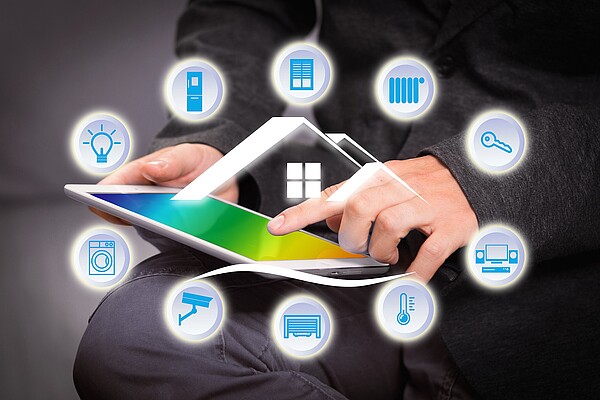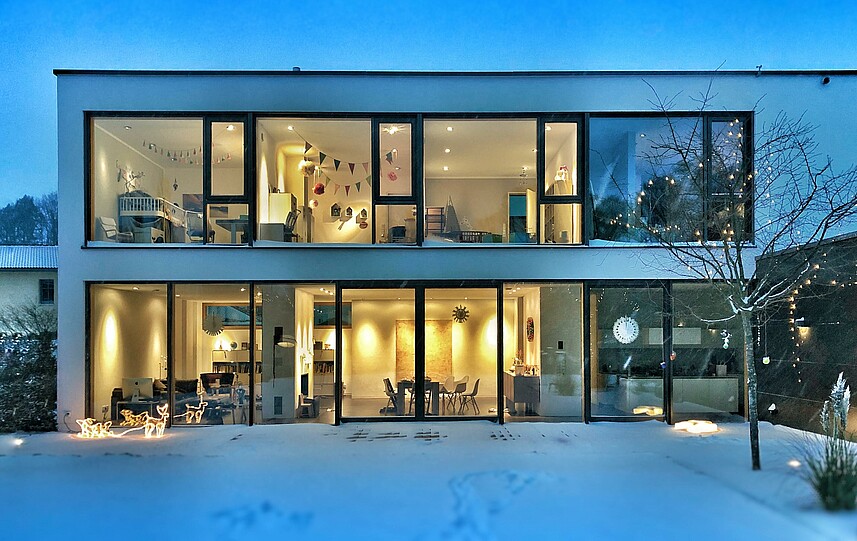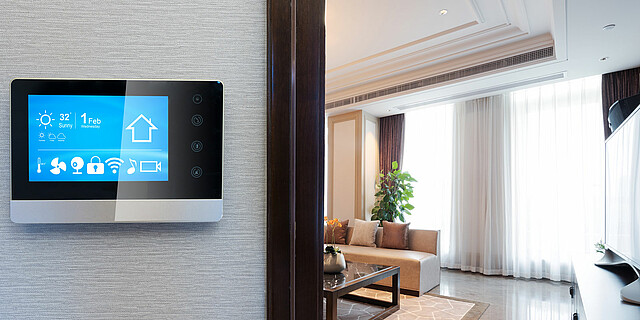When walls become lungs
Smart Home systems ensure healthier indoor air
What would it be like if your house could breathe like your lungs, if you were greeted at the front door and your car parked itself in the garage? Smart Home systems and the Internet of Things are already beginning to influence the way we live today. But the future will see many more opportunities opening up, not least the composition and quality of indoor air.
With a low hum, the car door opens. In front of you stands a young man. He has brown hair and is wearing a blue shirt and black tie. He smiles as he welcomes you home. You get out. You touch him briefly on the shoulder and the image flickers. No surprise there, because the young man is a hologram: a three-dimensional representation of the artificial intelligence that connects all the devices in your house.

As if by magic, your self-driving car glides into the garage on invisible magnetic tracks. As you walk to your front door and step onto the doormat, the door opens. You enter your home. The air is pleasantly warm. You breathe deeply. The ambient temperature is a comfortable 23 degrees Celsius – information relayed via augmented reality to your glasses. Yet your home has no heating system at all. The relative humidity is a perfect 53 percent, even with the windows closed. You lean your back against the wall and feel a gentle breeze caress your neck. How will air enter the house of tomorrow?

Smart construction technology
It’s all about new construction materials. In the house of tomorrow, the walls and even the paint will be breathable. Oxygen and fresh air will be guided indoors as required. At the same time odors, pollutants and excess moisture will be exhaled from the house in a controlled manner – just as you absorb oxygen through your lungs and exhale carbon dioxide. One way of doing this is through flexible, electrically charged pores in the building materials, whose size can be manipulated by redistributing the electrical charges. When biomembranes in the paint detect a change in room air quality, the pores open or close to maintain your desired blend of temperature, moisture and purity.
Efficient defense against pollutants
Effective filters are the key to preventing pollutants in the outside air from reaching the inside. Nonwoven materials coated with activated carbon, which are attached to the wall like wallpaper, enable reliable adsorption – even in the most confined spaces. Activated carbon is woven into the fabric to absorb nitrogen dioxide before it penetrates the interior. Under prolonged exposure, this gaseous oxidation product can cause bronchial constriction, especially in asthmatics.

Thanks to the activated carbon filters, the concentration in your home remains well below the average value of 15 micrograms per square meter. This is because the filters integrated into your walls wall are controlled by a Smart Home system. Once you have taught the artificial intelligence function precisely what you require of the room air, it will then automatically compute the optimum guide value. In future, the only thing that will enter through the windows will be light; the air will “breathe” in and out of the walls.
Heating without heating
A further advantage of this technology is energy efficiency, especially when it comes to heating. This is because the system only activates ventilation when the air quality deviates from your desired reference value. Coupled with effective thermal insulation, heat energy loss is almost non-existent. The result is that the room temperature will remain stable at between 20 and 23 degrees Celsius – without any heating at all.
The heat that photovoltaic systems store on the roof is retained in the cycle. There is no need to actively ventilate the rooms. Even the moisture concentration never falls below 40 percent, at which point it would cause severe irritation of the mucous membranes, skin and eyes. But it never rises above 60 percent either, eliminating the formation of mold and adding to overall wellbeing. If fungal spores penetrate into the respiratory tract, they can cause asthma and trigger allergies.
Farewell to sneezing
As well as fungal spores, extended inhalation of other allergens such as volatile organic compounds (VOCs) can also cause allergies. These include hydrocarbons, alcohols and organic acids – aerogenic substances that are released by building materials, cleaning agents or tobacco smoke. When inhaled, they cause irritation and inflammation of mucous membranes, which also triggers allergies. Other airborne pollutants such as formaldehyde, which is mainly found in new buildings, can cause even more serious health problems, up to and including cancer.
One way to prevent this risk is to conduct a comprehensive indoor air analysis. If excessive concentrations are detected, an intelligent air filter system adsorbs the pollutants from the room air. This keeps the average total concentration below 0.1 part per million, which is a good guide value. Smart houses have a strong focus on health, which makes good sense. In industrialized countries, it is estimated that we spend up to 90 percent of our lives indoors.
Sustainable filter solution

The importance of good indoor air makes reliable air filters essential. Freudenberg Filtration Technologies can provide the ideal solutions. For example, our multifunctional indoor air filter features a carbon-impregnated medium designed to deal with aerogenic pollutants such as formaldehyde, VOCs or ammonia. If required, this can be enhanced by an integrated biocide- and nanosilver-free biofunctional layer, which offers triple protection against air pollutants and household contaminants. This multi-layer system is an ideal combination of gas phase and particle filters. To increase the longevity of the system, upstream filters perform a prefiltration function to reduce the workload of the high-tech multifunctional filter.
With Smart Home applications such as an air filter sensor, a series of complementary filter options can be efficiently deployed in an energy-saving manner. The incredibly fine sensor cable running through the filter reacts to the smallest stimuli and lets the artificial intelligence know if a filter is still working optimally or needs to be replaced. The smart house provides information on whether the room air sensors have detected a deviation from the reference value and ventilation is required. In other words – smart filters that are deployed only when they are needed.
Sources:
- https://www.statista.com/topics/2430/smart-homes/
- https://www.allergieinformationsdienst.de/immunsystem-allergie/entstehung-von-allergien.html
- https://www.ifau.org/allergene/Dienstleistungen_Allergene_in_Innenraeumen.htm
- http://www.innenraumluft.nrw.de/4_schadstoffe/voc.php
- https://www.wohnen-sie-gesund.de/schadstoff-abc/f/formaldehyd/











